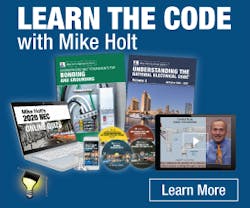Stumped by the Code? NEC Requirements for Short-Circuit Current Rating of Switchboards, Switchgear, or Panelboards
Courtesy of www.MikeHolt.com
All questions and answers are based on the 2020 NEC.
Q. What does the NEC require for short-circuit current rating of switchboards, switchgear, or panelboards?
A. Switchboards and panelboards must have a short-circuit current rating of not less than the available fault current. In other than one- and two-family dwellings, the available fault current and the date the calculation was performed must be field-marked on the enclosure at the point of supply. The marking must be of sufficient durability to withstand the environment involved following Sec. 110.21(B)(3) [Sec. 408.6] (see Figure below).
Q. What are the NEC requirements for GFCI protection of appliances?
A. The following appliances rated 150V or less and 60A or less must be GFCI protected by Class “A” protective device(s) [Sec. 422.5(A)]:
(1) automotive vacuum machines,
(2) drinking water coolers and bottle fill stations,
(3) cord- and plug-connected high-pressure spray washing machines,
(4) tire inflation machines,
(5) vending machines,
(6) sump pumps, and
(7) dishwashers.
Note: Sec. 210.8 specifies requirements for GFCI protection for the receptacle outlets where the location warrants such protection.
In addition, the GFCI must be readily accessible and located in one or more of the following locations [Sec. 422.5(B)]:
(1) a GFCI circuit breaker,
(2) a GFCI device or receptacle,
(3) a GFCI integral with the attachment plug,
(4) a GFCI within the supply cord not more than 12 in. from the attachment plug, or
(5) a factory-installed GFCI within the appliance.
Q. What is the Code requirement for sizing the overcurrent device and conductors for an electric water heater with a capacity of 120 gal or less?
A. The branch-circuit overcurrent device and conductors for fixed storage-type water heaters that have a capacity of 120 gallons or less must be sized not smaller than 125% of the rating of the water heater [Sec. 422.13].
How do size the conductors and overcurrent protection device? Let’s run through an example to show you how.
Example: What size conductor and overcurrent protection are required for a 4,500W, 240V water heater, having a wiring method or Type NM cable?
Solution: First, determine the branch-circuit rating and conductor size.
Circuit Current = 4,500W ÷ 240V = 18.75A
Circuit Rating = 18.75A × 125% = 23.44A
Circuit Conductor = 10 AWG rated 30A at 60°C [Sec. 110.14(C)(1)(a)(2), Sec. 334.80, and Table 310.16]
Next, determine the overcurrent protection rating.
Circuit Current = 4,500W ÷ 240V = 18.75A
Circuit Protection = 18.75A × 125% = 23.44A, use next size up rule: 25A [Sec. 240.6(A)].
Note: Sec. 422.11(E)(3) permits the overcurrent protective device to be sized up to 150% of the appliance rating.
Circuit Protection = 18.75A × 150% = 28.75A, use next size up rule: 30A [Sec. 240.6(A)]
Q. What is the NEC requirement for the listing of appliances?
A. As per Sec. 422.6, appliances supplied by 50V or higher must be listed.
These materials are provided to us by Mike Holt Enterprises in Leesburg, Fla. To view Code training materials offered by this company, visit www.mikeholt.com/code.






